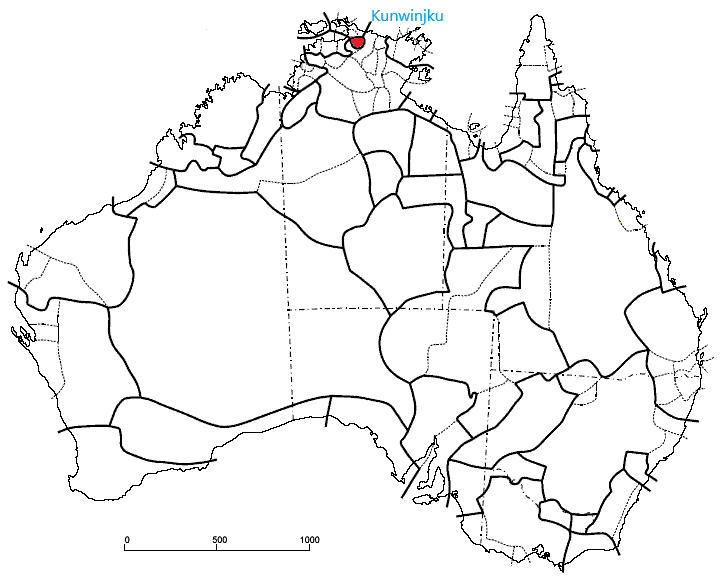Kunwinjku on:
[Wikipedia]
[Google]
[Amazon]
 The Kunwinjku (formerly written Gunwinggu) people are an
The Kunwinjku (formerly written Gunwinggu) people are an
 The Kunwinjku (formerly written Gunwinggu) people are an
The Kunwinjku (formerly written Gunwinggu) people are an Australian Aboriginal
Aboriginal Australians are the various indigenous peoples of the Mainland Australia, Australian mainland and many of its islands, excluding the ethnically distinct people of the Torres Strait Islands.
Humans first migrated to Australia (co ...
people, one of several groups within the Bininj people, who live around West Arnhem Land
Arnhem Land is a historical region of the Northern Territory of Australia. It is located in the north-eastern corner of the territory and is around from the territorial capital, Darwin, Northern Territory, Darwin. In 1623, Dutch East India Compa ...
to the east of Darwin, Northern Territory
Darwin ( Larrakia: ') is the capital city of the Northern Territory, Australia. The city has nearly 53% of the Northern Territory's population, with 139,902 at the 2021 census. It is the smallest, wettest, and most northerly of the Australi ...
. Kunwinjku people generally refer to themselves as "Bininj" (meaning people, or Aboriginal people) in much the same way that Yolŋu
The Yolngu or Yolŋu ( or ) are an aggregation of Aboriginal Australian people inhabiting north-eastern Arnhem Land in the Northern Territory of Australia. ''Yolngu'' means "person" in the Yolŋu languages. The terms Murngin, Wulamba, Yalnumat ...
people refer to themselves as "Yolŋu".
Language
They traditionally speak theKunwinjku language
Kunwinjku is a dialect of Bininj Kunwok, an Australian Aboriginal language. The Aboriginal people who speak Kunwinjku are the Bininj people, who live primarily in western Arnhem Land
Arnhem Land is a historical region of the Northern Terri ...
.
Country
Their original heartland is said to have been in the hilly terrain south of Goulburn Island and their frontier with the Maung running just south of Tor Rock. Their northern extension approached Sandy Creek, while they were also present south-east at the head of Cooper's Creek and part of the King River. InNorman Tindale
Norman Barnett Tindale AO (12 October 1900 – 19 November 1993) was an Australian anthropologist, archaeologist, entomologist and ethnologist. He is best remembered for his work mapping the various tribal groupings of Aboriginal Australians ...
's scheme, the Kunwinjku were allotted a tribal territory of around in the area south of Jungle Creek and on the headwaters of the East Alligator River
Alligator Rivers is the name of an area in an Arnhem Land region of the Northern Territory of Australia, containing three rivers, the East, West, and South Alligator Rivers. It is regarded as one of the richest biological regions in Australia, ...
. The Gumader swamps near Junction Bay and the creeks east of Oenpelli/''Awunbelenja'' (now Gunbalanya) also formed part of their land.
Alternative names
* ''Gunwinggu'' * ''Gunwingu'' * ''Gunwingo'' * ''Wengi, Wengei, Wengej'' * ''Gundeidjeme'' * ''Gundjeipmi'' * ''Kulunglutji, Kulunglutchi'' * ''Gundjeibmi, Gundjajeimi, Gundeijeme, Gundeidjeme'' * ''Margulitban'' * ''Unigangk, Urnigangg'' * ''Koorungo'' * ''Neinggu/Neiŋgu'' ( Maungexonym
An endonym (also known as autonym ) is a common, name for a group of people, individual person, geographical place, language, or dialect, meaning that it is used inside a particular group or linguistic community to identify or designate them ...
)
* ''Mangaridji''
* ''Mangeri''
Customs
Dzamalag was a form of ritualised ceremonial exchange orbarter
In trade, barter (derived from ''bareter'') is a system of exchange (economics), exchange in which participants in a financial transaction, transaction directly exchange good (economics), goods or service (economics), services for other goods ...
ing practised by the Gunwinggu people.
Notes
Citations
Sources
* * * * * * * * * {{authority control Aboriginal peoples of the Northern Territory Indigenous Australians in the Northern Territory